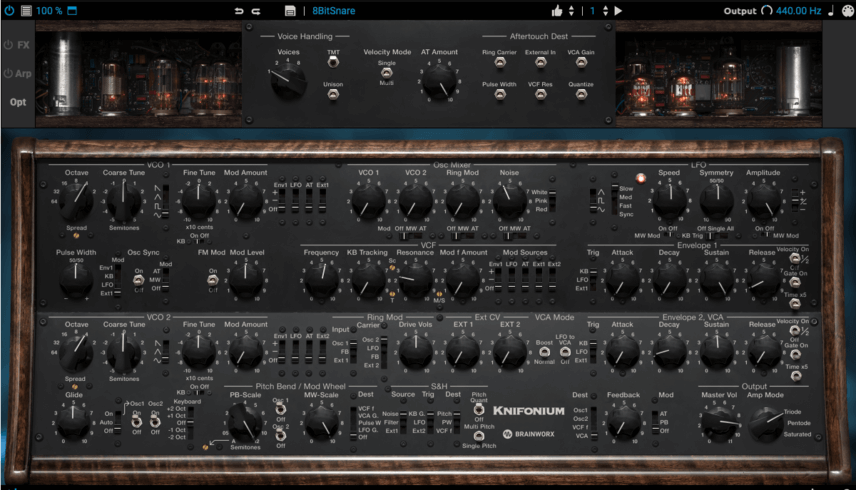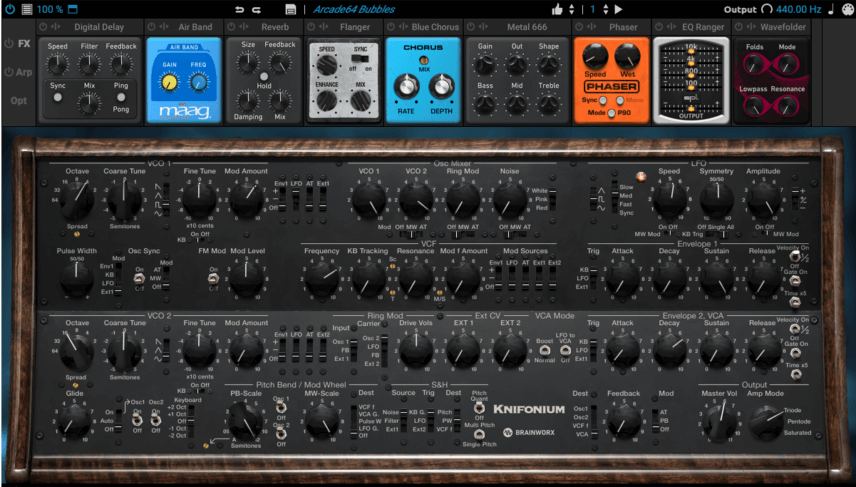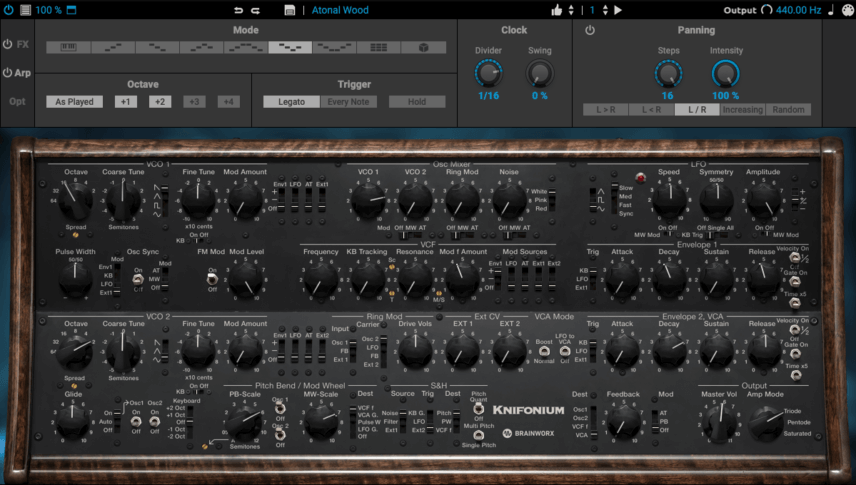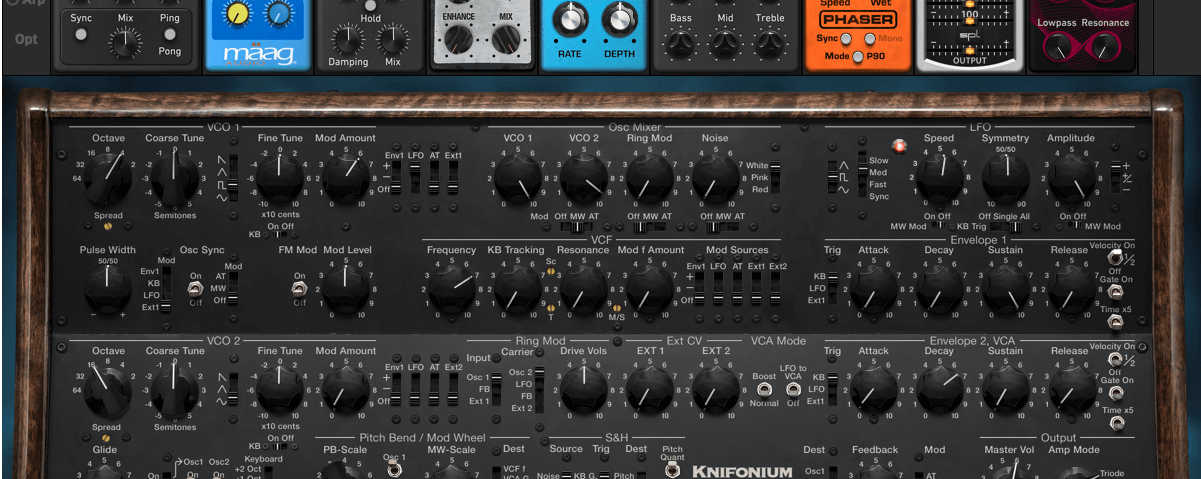Just when you think every worthwhile synthesizer has been emulated for the plugin domain, along comes Knif Audio’s Knifonium to prove you very, very wrong.
Developed by top-shelf plugin team Brainworx and the hardcore hardware boffins at Knif Audio with help from Plugin Alliance, Knifonium (pronounced with a hard ‘K’) is a recreation of the boutique synth of the same name, a handmade monophonic monster with 26 tubes and reverse-colour ebony keys. It’s also incredibly expensive (see: handmade) and thus out of the reach of most of us (unless you’re Hannes Bieger).
Knifonium (both the hardware and plugin) is a 1970s-style monophonic synthesizer with the usual complement of subtractive synthesis functionality: two oscillators, lowpass ladder filter, two envelopes, an LFO, plus a ring modulator and sample and hold circuit. While there’s quite a bit more than meets the eye (as we’ll soon see), what makes the Knifonioum truly special is what it does to the sound. As mentioned before, this hot beast has 26 tubes inside, each capable of saturating the signal in gorgeous, characterful ways. Brainworx has carefully modelled these using its TMT (Tolerance Modeling Technology). The result is more often than not glorious, unpredictable, and quite unlike any other plugin we’ve yet heard.
The Phat Of The Land
Much like that other famous monosynth, the Minimoog, the Knifonium seems preternaturally suited to bass. Take a look at the oscillators. They go down to 64’. That is low, my friends. Marianas Trench click territory. VCO 1 has four waveforms: inverse ramp, triangle, square, and sine. VCO 2 has the same, minus the square (which is a shame). The pulse width of VCO 1’s square wave can be modulated manually or via four different modulators, including Envelope 1, the keyboard, LFO, and even an external source (wait, what? Yes, indeed). The fact that there are so many modulation options even for just the pulse width is a little surprising but this carries through across the whole synth, and is one of the things that makes it so unique.

We mentioned the Minimoog before. The Knifonium doffs its cap to it again in the filter section, which is a Moog-style fourth-order ladder filter. As you’d expect, it’s creamy and great for shaping tone, particularly when it comes to bass. And, as with the Minimoog, the filter will self-oscillate at higher settings.
Two envelopes, one hardwired to the VCA and the other assignable, handle volume and modulation shaping duties. Additionally, the timing of the envelopes can be slowed right down. As with some models in the classic Yamaha CS series, they can be extended to 5x speed. This is great for long, lazy pads and drones.
Let’s Get Brutal
All that we’ve mentioned so far is par for the course for most any classic monosynth. What makes Knifonium special is the sound and how it’s affected by all those tubes. With every tube, the sound gets warmer and more saturated. Upping oscillator gain at the mixer stage will do it, as will overall output volume. In fact, it’s tough to get a clean signal from it, as the Amp Mode dial in the output section will prove. You have a choice between three distortion modes: Triode, Pentode, and Saturated. Notice there’s no clean option!
There are plenty of other ways to dirty up your signal too. In the oscillator section, there’s frequency modulation, which is handy for roughing things up. The ring mod is particularly nice, with separate drive and volume knobs and a number of options for input and carrier signals, including feedback. Yes, there’s a feedback circuit, with destinations including either oscillator, the VCA or the filter. Get all of this going—saturation, feedback, ring mod, a little frequency modulation—and you’re into some serious dark territory. Think techno, industrial, Trent Reznor soundtracks. And yet with all this dirt, it’s never harsh and always musical. Quite a feat, this.
From Mono To Stereo
While the Knifonium has plenty of modulation options and features you don’t see on other synths (such as LFO symmetry and both fine and course speed adjustments) at its heart it’s very traditional, almost old fashioned. However, Brainworx have added some surprisingly modern functionality to it in the form of stereo and mid/side processing.

The stereo width of each oscillator can be adjusted from 0% (mono) to 100%. Tweak these settings correctly and you’re in for some very wide sounds. Additionally, and rather uniquely, the filter has mid/side spread adjustment. At 12 0’clock, both mid and side signals pass through the filter as you’d expect. Turning it to the right or left controls how much of each signal is affected and how much the other is not. For example, turning it all the way to the left will send the mid signal through the filter while bypassing the side signal entirely. Turning it to the right will yield the opposite results. It offers a level of imaging flexibility not often seen in a monophonic synth plugin.
Effects and Arpeggiator
As with bx_oberhausen, Brainworx’s superb version of the Oberheim SEM, the developer has included a selection of high-class effects to further extend the shelf life of the synth. They include a delay, reverb, flanger, the company’s famous Blue Chorus, phaser, EQ, and Mäag Air Band, which can help lighten up your sound should it become too dark with saturation. If you need more dirt (and why not?) Brainworx have helpfully included the Metal666 amp simulation and Wavefolder distortion effect.

The arpeggiator will also look familiar to bx_oberhausen users, with a variety of arp modes, clock divider, swing, and stereo panning. Be careful that your stereo imaging doesn’t get too out of hand, especially with bass patches!
The Verdict
The Knif Audio Knifonium is surprisingly deep. There’s plenty we haven’t even mentioned (noise, unison mode, polyphony, and aftertouch and modulation wheel functionality). This is a synthesizer to explore and get lost in. It’s also one to luxuriate in. With all those tubes warming things up, the sound is smokey, characterful and classy, like an aged single-malt whiskey. There are notes of classic analogue synths yet also hints of Novachord and other early, pre-synthesizer electronic instruments.
Here’s the bad news: although it’s much cheaper than buying the hardware version, Knifonium retails for $299, although at the time of publication it was discounted to $199.99. (It’s also part of Plugin Alliance’s Musician and Mega Bundles.) It’s also not easy on the CPU, particularly with TMT mode engaged. However, the sound is jaw-dropping and there really isn’t anything else like it on the market.
Knifonium is a special synthesizer. The original is made entirely by hand, with a fanatical attention to detail. The plugin version is equally unique, with its mix of traditional synthesis and modern stereo imaging functionality. And it sounds divine. They say that you get what you pay for and in this case it’s true.
